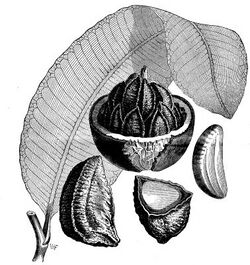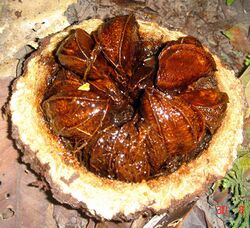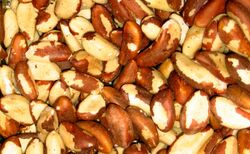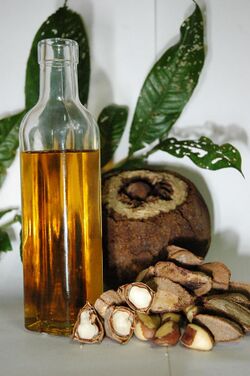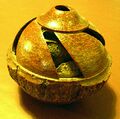Biology:Brazil nut
| Brazil nut tree | |
|---|---|

| |
| Scientific classification | |
| Kingdom: | Plantae |
| Clade: | Tracheophytes |
| Clade: | Angiosperms |
| Clade: | Eudicots |
| Clade: | Asterids |
| Order: | Ericales |
| Family: | Lecythidaceae |
| Genus: | Bertholletia Bonpl. |
| Species: | B. excelsa
|
| Binomial name | |
| Bertholletia excelsa Humb. & Bonpl.
| |
The Brazil nut (Bertholletia excelsa) is a South American tree in the family Lecythidaceae, and it is also the name of the tree's commercially harvested edible seeds.[2] It is one of the largest and longest-lived trees in the Amazon rainforest. The fruit and its nutshell – containing the edible Brazil nut – are relatively large, possibly weighing as much as 2 kg (4.4 lb) in total weight. As food, Brazil nuts are notable for diverse content of micronutrients, especially a high amount of selenium. The wood of the Brazil nut tree is prized for its quality in carpentry, flooring, and heavy construction.
Common names
In Portuguese-speaking countries, like Brazil, they are variously called "castanha-do-brasil"[3][4] (meaning "chestnuts from Brazil " in Portuguese), "castanha-do-pará" (meaning "chestnuts from Pará" in Portuguese), with other names: castanha-da-amazônia,[5] castanha-do-acre,[6] "noz amazônica" (meaning "Amazonian nut" in Portuguese), noz boliviana, tocari ("probably of Carib origin"[7]), and tururi (from Tupi turu'ri[8]) also used.[2]
In various Spanish-speaking countries of South America, Brazil nuts are called castañas de Brasil, nuez de Brasil, or castañas de Pará (or Para).[2][9]
In North America, as early as 1896, Brazil nuts were sometimes known by the slang term "nigger toes",[10][11][12] a vulgarity that fell out of use after the racial slur became socially unacceptable.[13][14]
Description
The Brazil nut is a large tree, reaching 50 metres (160 feet) tall,[15] and with a trunk 1 to 2 m (3 to 7 ft) in diameter, making it among the largest of trees in the Amazon rainforest. It may live for 500 years or more, and can often reach a thousand years of age.[16] The stem is straight and commonly without branches for well over half the tree's height, with a large, emergent crown of long branches above the surrounding canopy of other trees.
The bark is grayish and smooth. The leaves are dry-season deciduous, alternate, simple, entire or crenate, oblong, 20–35 centimetres (8–14 inches) long, and 10–15 cm (4–6 in) broad. The flowers are small, greenish-white, in panicles 5–10 cm (2–4 in) long; each flower has a two-parted, deciduous calyx, six unequal cream-colored petals, and numerous stamens united into a broad, hood-shaped mass.[citation needed]
Reproduction
Brazil nut trees produce fruit almost exclusively in pristine forests, as disturbed forests lack the large-bodied bees of the genera Bombus, Centris, Epicharis, Eulaema, and Xylocopa, which are the only ones capable of pollinating the tree's flowers, with different bee genera being the primary pollinators in different areas, and different times of year.[17][18][19] Brazil nuts have been harvested from plantations, but production is low and is currently not economically viable.[2][15][20]
The fruit takes 14 months to mature after pollination of the flowers. The fruit itself is a large capsule 10–15 cm (4–6 in) in diameter, resembling a coconut endocarp in size and weighing up to 2 kg (4 lb 7 oz). It has a hard, woody shell 8–12 mm (3⁄8–1⁄2 in) thick, which contains eight to 24 wedge-shaped seeds 4–5 cm (1 5⁄8–2 in) long (the "Brazil nuts") packed like the segments of an orange, but not limited to one whorl of segments. Up to three whorls can be stacked onto each other, with the polar ends of the segments of the middle whorl nestling into the upper and lower whorls (see illustration above).
The capsule contains a small hole at one end, which enables large rodents like the agouti to gnaw it open.[21] They then eat some of the seeds inside while burying others for later use; some of these are able to germinate into new Brazil nut trees.[21] Most of the seeds are "planted" by the agoutis in caches during wet season,[21] and the young saplings may have to wait years, in a state of dormancy, for a tree to fall and sunlight to reach it, when it starts growing again. Capuchin monkeys have been reported to open Brazil nuts using a stone as an anvil.
Taxonomy
The Brazil nut family, the Lecythidaceae, is in the order Ericales, as are other well-known plants such as blueberries, cranberries, sapote, gutta-percha, tea, phlox, and persimmons. The tree is the only species in the monotypic genus Bertholletia,[2] named after French chemist Claude Louis Berthollet.[22]
Distribution and habitat
The Brazil nut is native to the Guianas, Venezuela, Brazil , eastern Colombia, eastern Peru, and eastern Bolivia. It occurs as scattered trees in large forests on the banks of the Amazon River, Rio Negro, Tapajós, and the Orinoco. The fruit is heavy and rigid; when the fruits fall, they pose a serious threat to vehicles and potential for traumatic brain injury of people passing under the tree.[23]
Production
| Brazil nut production – 2020 | |
|---|---|
| Country | (tonnes) |
| 33,118 | |
| 30,843 | |
| 5,697 | |
| World | 69,658 |
| Source: FAOSTAT of the United Nations [24] | |
In 2020, global production of Brazil nuts (in shells) was 69,658 tonnes, most of which derive from wild harvests in tropical forests, especially the Amazon regions of Brazil and Bolivia which produced 92% of the world total (table).
Environmental effects of harvesting
Since most of the production for international trade is harvested in the wild,[25][26] the business arrangement has been advanced as a model for generating income from a tropical forest without destroying it.[25] The nuts are most often gathered by migrant workers known as castañeros (in Spanish) or castanheiros (in Portuguese).[25] Logging is a significant threat to the sustainability of the Brazil nut-harvesting industry.[25][26]
Analysis of tree ages in areas that are harvested shows that moderate and intense gathering takes so many seeds that not enough are left to replace older trees as they die.[26] Sites with light gathering activities had many young trees, while sites with intense gathering practices had nearly none.[27]
European Union import regulation
In 2003, the European Union imposed strict regulations on the import of Brazilian-harvested Brazil nuts in their shells, as the shells are considered to contain unsafe levels of aflatoxins, a potential cause of liver cancer.[28]
Toxicity
Brazil nuts are susceptible to contamination by aflatoxins, produced by fungi, once they fall to the ground.[29] Aflatoxins can cause liver damage, including possible cancer, if consumed.[28] Aflatoxin levels have been found in Brazil nuts during inspections that were far higher than the limits set by the EU.[30] However, mechanical sorting and drying was found to eliminate 98% of aflatoxins; a 2003 EU ban on importation[28] was rescinded after new tolerance levels were set.
The nuts often contain radium, a radioactive element, with a kilogram of nuts containing an activity between 40 and 260 becquerels (1 and 7 nanocuries). This level of radium is small, although it can be about 1,000 times higher than in other common foods. According to Oak Ridge Associated Universities, elevated levels of radium in the soil does not directly cause the concentration of radium, but "the very extensive root system of the tree" can concentrate naturally occurring radioactive material, when present in the soil.[31] Radium can be concentrated in nuts only if it is present in the soil.[32]
Brazil nuts also contain barium, a metal with a chemical behavior quite similar to radium.[33] While barium, if ingested, can have toxic effects, such as weakness, vomiting, or diarrhea,[34] the amount present in Brazil nuts are orders of magnitude too small to have noticeable health effects.
Uses
| Nutritional value per 100 g (3.5 oz) | |
|---|---|
| Energy | 2,743 kJ (656 kcal) |
12.27 g | |
| Starch | 0.25 g |
| Sugars | 2.33 g |
| Dietary fiber | 7.5 g |
66.43 g | |
| Saturated | 15.137 g |
| Monounsaturated | 24.548 g |
| Polyunsaturated | 20.577 g |
14.32 g | |
| Tryptophan | 0.141 g |
| Threonine | 0.362 g |
| Isoleucine | 0.516 g |
| Leucine | 1.155 g |
| Lysine | 0.492 g |
| Methionine | 1.008 g |
| Phenylalanine | 0.630 g |
| Tyrosine | 0.420 g |
| Valine | 0.756 g |
| Arginine | 2.148 g |
| Histidine | 0.386 g |
| Alanine | 0.577 g |
| Aspartic acid | 1.346 g |
| Glutamic acid | 3.147 g |
| Glycine | 0.718 g |
| Proline | 0.657 g |
| Serine | 0.683 g |
| Vitamins | Quantity %DV† |
| Thiamine (B1) | 54% 0.617 mg |
| Riboflavin (B2) | 3% 0.035 mg |
| Niacin (B3) | 2% 0.295 mg |
| Pantothenic acid (B5) | 4% 0.184 mg |
| Vitamin B6 | 8% 0.101 mg |
| Folate (B9) | 6% 22 μg |
| Vitamin C | 1% 0.7 mg |
| Vitamin E | 38% 5.73 mg |
| Minerals | Quantity %DV† |
| Calcium | 16% 160 mg |
| Iron | 19% 2.43 mg |
| Magnesium | 106% 376 mg |
| Manganese | 57% 1.2 mg |
| Phosphorus | 104% 725 mg |
| Potassium | 14% 659 mg |
| Sodium | 0% 3 mg |
| Zinc | 43% 4.06 mg |
| Other constituents | Quantity |
| Water | 3.48 g |
| Selenium | 1917 μg |
| Beta-sitosterol | 64 mg |
| |
| †Percentages are roughly approximated using US recommendations for adults. Source: USDA Nutrient Database | |
Nutrition
Brazil nuts are 3% water, 14% protein, 12% carbohydrates, and 66% fats (table). The fat components are 16% saturated, 24% monounsaturated, and 24% polyunsaturated (see table for USDA source).
In a 100 grams (3.5 ounces) reference amount, Brazil nuts supply 659 calories, and are a rich source (20% or more of the Daily Value, DV) of dietary fiber (30% DV), thiamin (54% DV), vitamin E (38% DV), magnesium (106% DV), phosphorus (104% DV), manganese (57% DV), and zinc (43% DV). Calcium, iron, and potassium are present in moderate amounts (10-19% DV, table).
Selenium
Brazil nuts are a particularly rich source of selenium, with just 28 g (1 oz) supplying 544 micrograms of selenium or 10 times the DV of 55 micrograms (see table for USDA source).[35] However, the amount of selenium within batches of nuts may vary considerably.[36]
The high selenium content is used as a biomarker in studies of selenium intake and deficiency.[37][38] Consumption of just one Brazil nut per day over 8 weeks was sufficient to restore selenium blood levels and increase HDL cholesterol in obese women.[38]
Oil
Brazil nut oil contains 48% unsaturated fatty acids composed mainly of oleic and linoleic acids, the phytosterol, beta-sitosterol,[39] and fat-soluble vitamin E.[40]
The following table presents the composition of fatty acids in Brazil nut oil (see USDA source in nutrition table):
| Palmitic acid | 10% |
| Palmitoleic acid | 0.2% |
| Stearic acid | 6% |
| Oleic acid | 24% |
| Linoleic acid | 24% |
| Alpha-linolenic acid | 0.04% |
| Saturated fats | 16% |
| Unsaturated fats | 48% |
Wood
The lumber from Brazil nut trees (not to be confused with Brazilwood) is of excellent quality, having diverse uses from flooring to heavy construction.[41] Logging the trees is prohibited by law in all three producing countries (Brazil, Bolivia, and Peru). Illegal extraction of timber and land clearances present continuing threats.[42] In Brazil, cutting down a Brazil nut tree requires previous authorization from the Brazilian Institute of Environment and Renewable Natural Resources.[43][44]
Other uses
Brazil nut oil is used as a lubricant in clocks,[45] in the manufacturing of paint and cosmetics, such as soap and perfume.[41] Because of its hardness, the Brazil nutshell is often pulverized and used as an abrasive to polish materials, such as metals and ceramics, in the same way as a jeweler's rouge. The charcoal from the nut shells may be used to purify water.[41]
Gallery
See also
| Wikimedia Commons has media related to Brazil nut. |
| Wikisource has the text of the 1911 Encyclopædia Britannica article Brazil Nuts. |
- Brazil nut cake
- List of culinary nuts
- Official list of endangered flora of Brazil
- Granular convection
References
- ↑ ((Americas Regional Workshop (Conservation & Sustainable Management of Trees, Costa Rica, November 1996))) (1998). "Bertholletia excelsa". IUCN Red List of Threatened Species 1998: e.T32986A9741363. doi:10.2305/IUCN.UK.1998.RLTS.T32986A9741363.en. https://www.iucnredlist.org/species/32986/9741363. Retrieved 2 December 2023.
- ↑ 2.0 2.1 2.2 2.3 2.4 Mori, Scott A.. "The Brazil Nut Industry – Past, Present, and Future". The New York Botanical Garden. http://www.nybg.org/bsci/braznut.
- ↑ "Nomes comuns: castanha-do-brasil, castanha-do-pará ou castanha-da-amazônia". http://ainfo.cnptia.embrapa.br/digital/bitstream/item/47749/1/folder-castanhadobrasil.pdf. - Folder Embrapa
- ↑ COSTA, J. R. (et al.).Uma das espécies nativas mais valiosas da floresta amazônica de terra firme é a castanha-do-brasil ou castanha-da-amazônia (Bertholletia excelsa), - Acta Amazônica vol. 39(4) 2009: 843 - 850
- ↑ Filho, João Carlos Meireles (2004) (in pt-BR). O livro de ouro da Amazônia: mitos e verdades sobre a região mais cobiçada do planeta. Ediouro. ISBN 978-85-00-01357-7. https://books.google.com/books?id=TvIrAAAAYAAJ&q=%22a%20%C3%BAnica%20conhecida%20fora%22. Retrieved 8 July 2023.
- ↑ "Negócios para Amazônia sustentável". http://www.ambiente.sp.gov.br/wp-content/uploads/cea/wwf_1.pdf. - Ministério do Meio Ambiente. Rio de Janeiro, 2003. p. 50.
- ↑ Shepard, Glenn H.; Ramirez, Henri (March 2011). ""Made in Brazil": Human Dispersal of the Brazil Nut (Bertholletia excelsa, Lecythidaceae) in Ancient Amazonia1". Economic Botany 65 (1): 44–65. doi:10.1007/s12231-011-9151-6.
- ↑ Ferreira, A. B. H. (1986). Novo Dicionário da Língua Portuguesa (2nd edition). Rio de Janeiro: Nova Fronteira. p. 1729
- ↑ PROYECTO PARA DECLARACIÓN DE ALÉRGENOS y SUSTANCIAS QUE PRODUCEN REACCIONES ADVERSAS EN LOS RÓTULOS DE LOS ALIMENTOS, CUALQUIERA SEA SU ORIGEN, ENVASADOS EN AUSENCIA DEL CLIENTE, LISTOS PARA SER OFRECIDOS AL CONSUMIDOR (DEC. 117/006 DEL RBN) (Report). Argentine government. n.d.. p. 3. http://www.puntofocal.gov.ar/notific_otros_miembros/ury45_t.pdf.
- ↑ Lyons, A. B. (2015). Plant Names, Scientific and Popular (2nd ed.). Arkose Press. p. 71. ISBN 978-1345211849.
- ↑ Young, W. J. (1911). "The Brazil Nut". Botanical Gazette 52 (3): 226–231. doi:10.1086/330613. https://zenodo.org/record/1431393.
- ↑ ""Nigger", noun and adjective". "Nigger", noun and adjective. 2019. https://www.oed.com/viewdictionaryentry/Entry/126934. Retrieved 29 November 2019.
- ↑ Essig, Laurie (12 July 2016). "White Like Me, Nice Like Me". Psychology Today. https://www.psychologytoday.com/us/blog/social-studies/201607/white-me-nice-me. Retrieved 29 November 2019.
- ↑ Brunvand, J. H. (1972). "The Study of Contemporary Folklore: Jokes". Fabula 13 (1): 1–19. doi:10.1515/fabl.1972.13.1.1. https://www.proquest.com/openview/e3d74c14ec7bc60598cb9d7711acc84f/1?pq-origsite=gscholar&cbl=1818081.
- ↑ 15.0 15.1 Hennessey, Tim (March 2, 2001). "The Brazil Nut (Bertholletia excelsa)". http://www.siu.edu/~ebl/leaflets/brazil.htm.
- ↑ Taitson, Bruno (January 18, 2007). "Harvesting nuts, improving lives in Brazil". World Wildlife Fund. http://www.assets.wwf.no/news_facts/newsroom/features/index.cfm?uNewsID=92320.
- ↑ Nelson, B. W.; Absy, M. L.; Barbosa, E. M.; Prance, G. T. (January 1985). "Observations on flower visitors to Bertholletia excelsa H. B. K. and Couratari tenuicarpa A. C. Sm. (Lecythidaceae)". Acta Amazonica 15 (1): 225–234. doi:10.1590/1809-43921985155234. https://www.researchgate.net/publication/315244593. Retrieved 2023-06-06.
- ↑ Moritz, A. (1984) (in pt). Estudos biológicos da floração e da frutificação da castanha-do-Brasil (Bertholletia excelsa HBK). 29. http://orton.catie.ac.cr/cgi-bin/wxis.exe/?IsisScript=ACERVO.xis&method=post&formato=2&cantidad=1&expresion=mfn=029738. Retrieved 2008-04-08.
- ↑ Cavalcante, M. C.; Oliveira, F. F.; Maués, M. M.; Freitas, B. M. (October 27, 2017). "Pollination Requirements and the Foraging Behavior of Potential Pollinators of Cultivated Brazil Nut (Bertholletia excelsa Bonpl.) Trees in Central Amazon Rainforest". Psyche: A Journal of Entomology 2012: 1–9. doi:10.1155/2012/978019.
- ↑ Ortiz, Enrique G.. "The Brazil Nut Tree: More than just nuts". http://www.bertholletia.org/bertholletia/benefits/body_benefits.html.
- ↑ 21.0 21.1 21.2 Haugaasen, Joanne M. Tuck; Haugaasen, Torbjørn; Peres, Carlos A.; Gribel, Rogerio; Wegge, Per (2010-03-30). "Seed dispersal of the Brazil nut tree (Bertholletia excelsa) by scatter-hoarding rodents in a central Amazonian forest". Journal of Tropical Ecology 26 (3): 251–262. doi:10.1017/s0266467410000027. https://www.researchgate.net/publication/230679775.
- ↑ Burkhardt, Lotte (2022) (in German) (pdf). Eine Enzyklopädie zu eponymischen Pflanzennamen. Berlin: Botanic Garden and Botanical Museum, Freie Universität Berlin. doi:10.3372/epolist2022. ISBN 978-3-946292-41-8. https://doi.org/10.3372/epolist2022. Retrieved January 27, 2022.
- ↑ "Traumatic brain injury caused by Brazil-nut fruit in the Amazon: A case series". Surgical Neurology International 12: 399. 2021. doi:10.25259/SNI_279_2021. PMID 34513165.
- ↑ "Brazil nut production in 2020; Crops/Regions/World list/Production Quantity (pick lists)". UN Food and Agriculture Organization, Corporate Statistical Database (FAOSTAT). 2020. http://www.fao.org/faostat/en/#data/QC.
- ↑ 25.0 25.1 25.2 25.3 Evans, Kate (7 November 2013). "Harvesting both timber and Brazil nuts in Peru's Amazon forests: Can they coexist?". Forests News. Center for International Forestry Research. https://forestsnews.cifor.org/16623/harvesting-both-timber-and-brazil-nuts-in-perus-amazon-forests-can-they-coexist?fnl=en.
- ↑ 26.0 26.1 26.2 Kivner, Mark (11 May 2010). "Intensive harvests 'threaten Brazil nut tree future'". BBC News: Science and Environment. https://www.bbc.com/news/10105273.
- ↑ Silvertown, J. (2004). "Sustainability in a nutshell". Trends in Ecology & Evolution 19 (6): 276–278. doi:10.1016/j.tree.2004.03.022. PMID 16701269.
- ↑ 28.0 28.1 28.2 "Commission Decision of 4 July 2003 imposing special conditions on the import of Brazil nuts in shell originating in or consigned from Brazil". Official Journal of the European Union: 33–38. 5 July 2003. 2003/493/EC. http://eur-lex.europa.eu/LexUriServ/LexUriServ.do?uri=OJ:L:2003:168:0033:0038:EN:PDF.
- ↑ "Aflatoxins in food" (in en). 1 March 2007. https://www.efsa.europa.eu/en/topics/topic/aflatoxins-food.
- ↑ "Research improves the control of Brazil nut contamination by mycotoxins" (in en). 2 August 2017. https://agencia.fapesp.br/research-improves-the-control-of-brazil-nut-contamination-by-mycotoxins/25782/.
- ↑ "Brazil Nuts". Oak Ridge Associated Universities. January 20, 2009. https://www.orau.org/health-physics-museum/collection/consumer/food/brazil-nuts.html.
- ↑ Adams, Rod (January 4, 2014). "BBC Bang Goes the Theory demonstrates that NOT all Brazil nuts are radioactive". https://atomicinsights.com/bbc-bang-goes-theory-changes-mind-brazil-nuts/.
- ↑ "Brazil Nuts" (in en). https://www.orau.gov/health-physics-museum/collection/consumer/food/brazil-nuts.html.[yes|permanent dead link|dead link}}]
- ↑ "Biomonitoring Summary" (in en-us). 2021-09-03. https://www.cdc.gov/biomonitoring/Barium_BiomonitoringSummary.html.
- ↑ "Selenium". Office of Dietary Supplements, US National Institutes of Health. 26 March 2021. https://ods.od.nih.gov/factsheets/selenium-HealthProfessional/.
- ↑ Chang, Jacqueline C.; Gutenmann, Walter H.; Reid, Charlotte M.; Lisk, Donald J. (1995). "Selenium content of Brazil nuts from two geographic locations in Brazil". Chemosphere 30 (4): 801–802. doi:10.1016/0045-6535(94)00409-N. PMID 7889353. Bibcode: 1995Chmsp..30..801C.
- ↑ Garcia-Aloy, Mar; Hulshof, Paul J. M.; Estruel-Amades, Sheila; Osté, Maryse C. J.; Lankinen, Maria; Geleijnse, Johanna M.; de Goede, Janette; Ulaszewska, Marynka et al. (2019-03-19). "Biomarkers of food intake for nuts and vegetable oils: an extensive literature search". Genes and Nutrition 14 (1): 7. doi:10.1186/s12263-019-0628-8. PMID 30923582.
- ↑ 38.0 38.1 Souza, R. G. M.; Gomes, A. C.; Naves, M. M. V.; Mota, J. F. (2015-04-16). "Nuts and legume seeds for cardiovascular risk reduction: scientific evidence and mechanisms of action". Nutrition Reviews 73 (6): 335–347. doi:10.1093/nutrit/nuu008. PMID 26011909. https://academic.oup.com/nutritionreviews/article/73/6/335/1845023.
- ↑ Kornsteiner-Krenn, Margit; Wagner, Karl-Heinz; Elmadfa, Ibrahim (2013). "Phytosterol content and fatty acid pattern of ten different nut types". International Journal for Vitamin and Nutrition Research 83 (5): 263–270. doi:10.1024/0300-9831/a000168. PMID 25305221.
- ↑ Ryan, E.; Galvin, K.; O'Connor, T. P.; Maguire, A. R.; O'Brien, N. M. (2006). "Fatty acid profile, tocopherol, squalene and phytosterol content of brazil, pecan, pine, pistachio and cashew nuts". International Journal of Food Sciences and Nutrition 57 (3–4): 219–228. doi:10.1080/09637480600768077. PMID 17127473.
- ↑ 41.0 41.1 41.2 "Bertholletia excelsa - Bonpl.". Plants for a Future. https://pfaf.org/User/Plant.aspx?LatinName=Bertholletia+excelsa.
- ↑ "Greenpeace Activists Trapped by Loggers in Amazon". Greenpeace. October 18, 2007. http://www.greenpeace.org/international/en/news/features/activists-trapped-by-loggers071018/.
- ↑ Moncrieff, Virginia M. (2015-09-21). "A little logging may go a long way". Forest News. Center for International Forestry Research. https://forestsnews.cifor.org/33554/brazil-nut-special-for-brazil-nuts-a-little-logging-may-go-a-long-way.
- ↑ de Oliveira Wadt, Lucia Helena; de Souza, Joana Maria Leite. "Árvore do Conhecimento – Castanha-do-Brasil" (in pt-br). https://www.agencia.cnptia.embrapa.br/gestor/castanha-do-brasil/arvore/CONT000g1kpc3vg02wx5ok00gmbp4skbjdei.html.
- ↑ Lim, T. K. (2012). Edible Medicinal And Non Medicinal Plants: Volume 3, Fruits. Springer Science & Business Media. ISBN 978-94-007-2534-8. https://books.google.com/books?id=32rWbxUtjeMC&pg=PA131.
Wikidata ☰ Q81671 entry
 |

